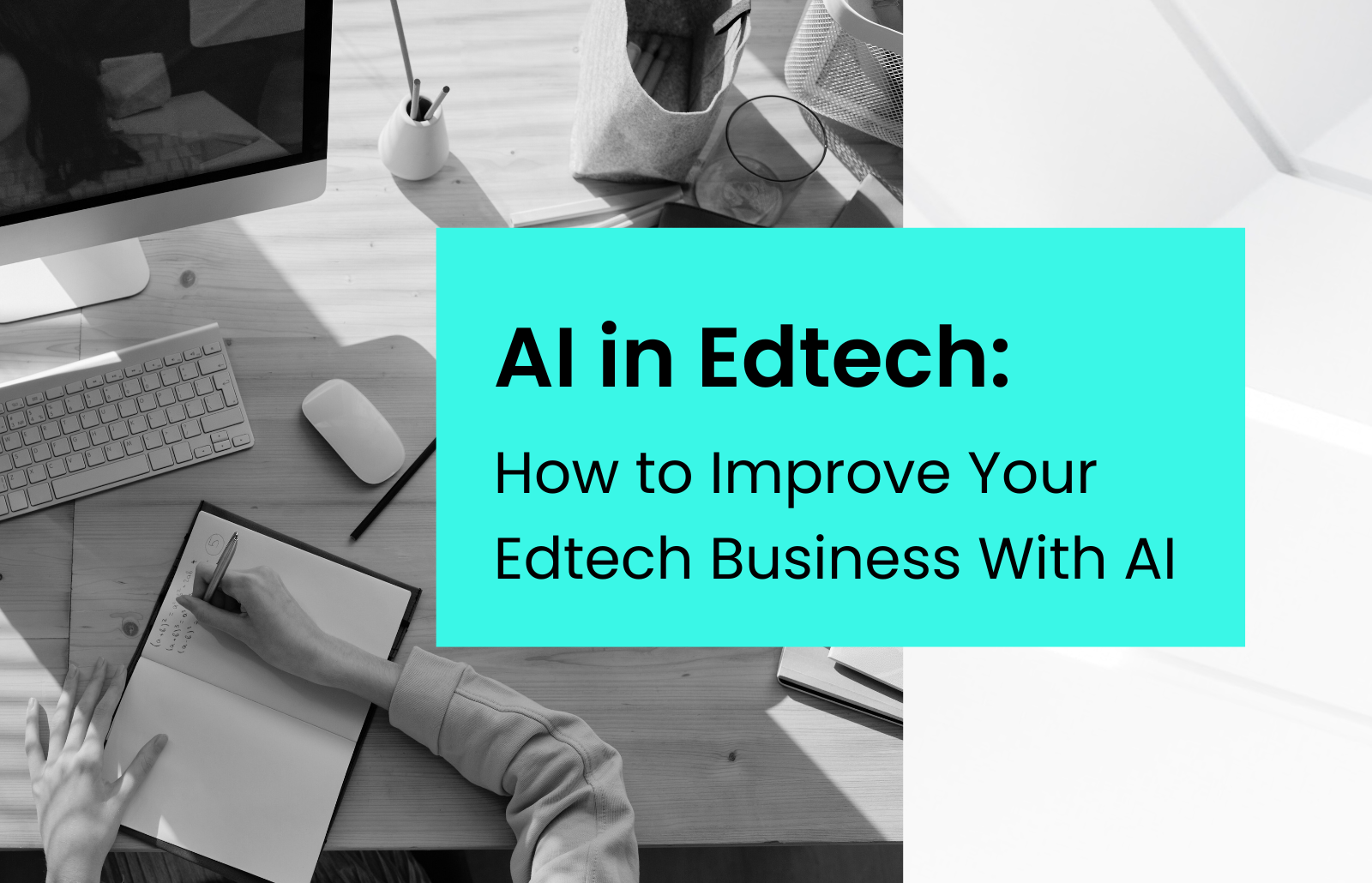Imagine a system that reviews students’ performance to identify their strengths and weaknesses; then provides extra support in areas where they struggle. How about an educational experience where teachers can lighten their workload by automating routine tasks such as lesson scheduling and documentation?
These scenarios are not a distant dream; they are already happening today thanks to the integration of AI in education. According to a Forbes Advisor survey, 60 percent of teachers have used AI to streamline their daily teaching responsibilities. Some of these educators use AI-powered gamification to engage their pupils and teach them creatively.
AI can streamline education in so many other ways. And that’s what we’ll discuss in this guide. You’ll also learn how to integrate AI-powered technologies into your Edtech business.
What Is AI in Edtech?
AI in Edtech involves the use of AI-powered technologies to facilitate learning. These technologies may include intelligent tutoring systems, adaptive learning platforms, natural language processing (NLP) models, and machine learning-based recommendation systems.
AI-driven solutions are streamlining learning experiences at different levels, whether in elementary school classes, college-level learning, or digital learning platforms such as Coursera and Duolingo.
They empower educators with features that help them better understand student behaviors and preferences. Then, these instructors can adjust their teaching approach to meet the students halfway. At the same time, AI helps students to unlock better academic performance. It reviews students’ learning methods and customizes learning pathways to help students learn the way that best suits them.
How to Leverage AI in Edtech
Here are some of the various ways to leverage artificial intelligence in education technology:
1. Personalized Learning
Personalized learning is one of the most vital applications of AI in the educational system. Every student learns differently, so a one-size-fits-all approach to education no longer suffices. With AI, teachers can create customized learning experiences that cater to each student’s strengths, weaknesses, and interests.
AI makes personalized learning possible by reviewing students’ learning behaviors and performance. Duolingo is a clear case of this application. This language-learning platform uses adaptive exercises to personalize lessons based on the user’s proficiency level and progress.
2. Task Automation
AI streamlines teaching and learning experiences through automation. For example, teachers can use AI-powered software to grade assignments and quizzes automatically. Additionally, some AI solutions can automate various administrative tasks, such as generating timetables and managing lesson schedules.
Generative AI in Edtech has also contributed significantly to automation. Teachers can use ChatGPT or other advanced NLP models to create lesson plans, presentations, and quizzes. Similarly, they can support their text materials with AI-generated images from DALL-E. With more time-consuming tasks set on auto-pilot, teachers would be able to focus more on teaching.
3. Predictive Analytics and Early Intervention
Another way to leverage artificial intelligence in education is to forecast students’ future academic performance. This method helps educators to spot at-risk students and figure out how to optimize their learning approach or environment.
What makes this AI use case highly important is its ability to track real-time data. The system may consider various metrics in predicting future outcomes such as:
- How often students log in to the learning platform
- Time spent engaging with course material or watching instructional videos
- Homework and quiz scores
- Average time taken to complete exercises
Since these metrics update instantly, it gives teachers enough time to reach out to students to assist them before it’s too late.
Benefits of AI Implementation in Edtech
The importance of AI in Edtech is increasingly obvious as more institutions adopt these technologies. Here are three main ways AI can help your Edtech business:
1. Simplify Administrative Tasks
AI streamlines administrative tasks such as enrolling students, scheduling classes, and managing resources. AI can automate these routine tasks, so educators don’t have to do them manually. This approach reduces mistakes and frees up time for teaching and helping students.
2. Reduced Paperwork
Another importance of AI in Edtech is the elimination of paperwork. With AI-powered digital platforms, there’s no need for printing, filing, or storing paper documents. Everything is digital, which is better for the environment and more efficient for the school.
3. Automated Real-time Reporting
AI also creates reports automatically as they unfold. It can analyze data about students’ progress and represent them with numbers and visual aids on dashboards. This simplified display saves teachers from having to analyze data and make reports themselves. With AI-generated reports, they can quickly see what’s happening and plan accordingly.
Challenges of Implementing AI in Edtech
Adopting AI technologies in your educational institution is a challenging undertaking. Here are some issues you’ll likely encounter:
1. Teacher Resistance
Some teachers may be hesitant to use AI tools in the classroom. They might worry about losing their jobs or think technology could replace student-teacher interactions. Nevertheless, the truth is that AI tools are meant to assist teachers, not replace them. With proper training and a supportive environment, educators can see the benefits of using AI and learn how to work with intelligent tools.
2. Concerns About Teaching Quality
Some people worry that AI could compromise teaching quality. The popular idea is that AI might be too rigid or limit teachers’ freedom. Others worry it could reduce personal connections in the classroom. However, AI is designed to support personalized, engaging teaching – not detract from it. While AI improves learning through automation, teachers will still have the same opportunity they’ve always had to engage students in meaningful interactions.
3. High Implementation Costs
Bringing AI into schools can be expensive. You need to pay for software, hardware, and training for teachers. This high cost makes it hard for some schools to use AI. To afford it, you might need to find funding sources, team up with tech companies, or choose lower-cost AI options that can grow with your needs.
How to Implement AI Strategies for Your Edtech Businesses
Ready to adopt AI into your Edtech venture? These are some practical steps to take:
1. Understand Your Needs And The Possibilities of AI
The first step in implementing AI in Edtech is to find out what AI can or cannot do to help your platform. Explore Edtech case studies and emerging AI Edtech companies to find untapped AI applications. Learn from similar educational organizations that are already using AI successfully.
Organize brainstorming sessions where you consult with teachers, students, and other stakeholders to find out areas where the institution or platform can improve.
2. Collaborate With Experts
Partner with AI experts and software developers who possess the resources and experience to help you develop and apply AI solutions. If you’re looking for a trustworthy option, Zartis is one of the best AI Edtech companies to consider.
We offer comprehensive AI consulting services that maximize artificial intelligence in education. Our dedicated team starts by validating your ideas. Then, we go on to uncover areas in your workflow that can benefit from automation.
3. Test And Learn
A good way to explore AI for education is to start small projects and tests. Instead of going all in, begin with applying AI in specific areas like personalized learning, or chatbot tutors. Run these small AI trials first. Then, use what you learn to improve your approach.
Focus your efforts on the most promising use cases. After successfully executing your strategy in some workflows, you can then expand to other areas that can benefit from automation.
Future Trends And Innovations in AI-Driven Edtech
Here are some key changes we can expect to see with artificial intelligence in education technology:
1. Integration of AI With AR/VR
Augmented and virtual reality overlay digital information in the real-world environment, making users experience a “fake reality”. This concept has always been explored in entertainment, but we’re about to see it go mainstream in education.
Already, Google Earth VR allows users to explore the world from a bird’s-eye view. It can be used to teach students about geography and culture. Nevertheless, it can be used to achieve more educational simulations. Soon, students will likely be able to enter a virtual classroom and interact with 3D instructors.
2. Ethical Considerations
Artificial intelligence is rapidly changing our world and is raising concerns about data privacy and responsible use. These risks call for a comprehensive legislative framework to govern the safe and responsible use of generative AI in Edtech. The European Union has reacted to this issue by enforcing the EU AI Act. Similarly, there’s been more AI legislation in the US. Over time, more policymakers will join in addressing these ethical concerns.
3. Explosive Growth
Using these innovations for educational purposes is carving out an industry set to exceed expectations in years to come. According to Global Market Insights, AI in education was valued as a $4 billion industry in 2022 and is expected to grow at 10 percent from 2023 to 2032.
Additionally, considering the European Union’s (EU) plan to propagate digital education, we can expect more AI Edtech startups to emerge and fill in the gap of increasing demand for personalized learning experiences.
Conclusion: Empowering Edtech for Better Learning With Zartis
Now you’ve seen the different ways to apply AI to your Edtech business. Take a bold step today and make AI work for you. Start by studying the top AI Edtech companies to see areas where they adopted AI.
Next, discuss with your stakeholders to identify opportunities for automation. Finally, collaborate with AI experts who have special Edtech experience.
Top AI consultants like Zartis can help you develop and deploy AI strategies to streamline your Edtech business. Our AI consulting services are built to help companies identify opportunities and achieve them!
Contact us today to learn more about how we can help you!





